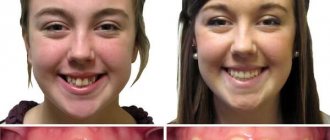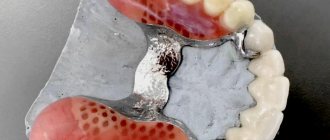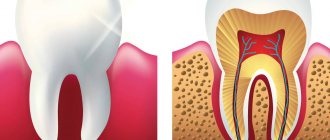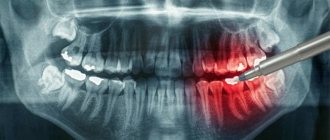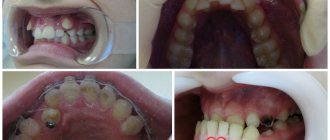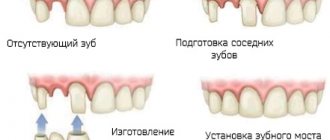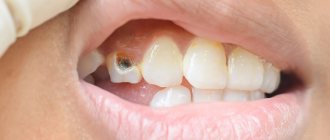Braces are metal clasps that are attached to the teeth. But they themselves do not correct the position of the teeth - the braces system does this. The main element of the system is the arc. It is this that affects the teeth, causing them to move. To do this, the arch is changed several times during the treatment process.
Arches for braces are made of a metal alloy. Most often it is nickel and titanium or titanium and molybdenum. At the request of the patient, you can choose an arch with a white coating - it visually goes well with ceramic or sapphire braces and is almost invisible. True, the white coating wears off quickly, so such an arch can be considered more as an option for a special occasion, for example, a wedding or graduation.
With a white arch, transparent braces are almost invisible
Basic properties of the arc:
- Strength. Braces can come off from the teeth, especially if you do not follow the rules of nutrition (gnaw nuts, crackers). But it is almost impossible to break or bend the arc.
- Flexibility and resilience. Regardless of what position the arch takes, it will tend to its original shape, similar to half an oval (except for the arch of lingual braces - it repeats the shape of the regular dentition not from the outside, but from the inside, so it looks different).
No matter how bent the arch is at the beginning of treatment, it tends to return to its shape
- Hypoallergenic. The arc is made of a material that does not cause allergies and a metallic taste in the mouth. It is not magnetic and does not “ring” at the airport when going through security.
Why are the arcs different in cross-sectional shape?
All arches for vestibular brace systems differ in thickness and cross-sectional shape. And this difference is important in the process of correcting the bite.
Arcs vary in thickness and cross-section
At the beginning of treatment, an arch with a circular cross-section is installed. She is the thinnest. It is inserted into the grooves of the bracket, which are rectangular on the inside. Therefore, the round arc does not completely fill the grooves.
The fact is that by the start of treatment, the patient’s teeth have been in the wrong position for 10–20 years or even longer (depending on how much time has passed since the formation of a permanent bite). Therefore, in the first month of treatment you should not exert too much pressure on them - this will cause great discomfort. First you just need to start moving your teeth.
The thinner the arch, the less space it takes up in the bracket grooves and the softer the effect on the teeth.
After 1–2 months of wearing braces, the roots of the teeth are already in a more mobile state. Many patients feel as if their teeth are loose. This is only partly true: the teeth do move, but the loosening is limited by the braces system and is not worth worrying about.
But now you can install a more rigid arch with a square cross-section. It fills the grooves of the braces more tightly, but still not completely. Square arches are used for several months during the main stage of treatment.
Square arch braces
At the final stage, it is the turn of the rectangular arc - the thickest and toughest. It completely fills the grooves of the braces, fixing the position of the teeth. This arch is put on when the desired result is achieved. Its function is to stabilize the teeth.
Braces cannot be removed immediately after teeth are straightened. You need to go through one more stage of treatment to consolidate the result. Patients go through this stage emotionally difficult: the teeth are already straight, but the braces are not removed and the arch is thick and noticeable. But this is necessary for complete treatment.
ANOMALIES OF DENTAL ARCH RELATIONSHIP
Anomalies of the dental arches are mainly congenital pathologies and manifest themselves in lengthening, shortening, narrowing or expansion of the dentition or its individual sections. There are also disturbances in the relationship of the dental arches, when there is an asymmetry in the location of the upper or lower jaw in relation to each other. These pathologies are identified during examination and classified depending on the clinical picture.
For information about prices and treatment times, call:
+7
or fill out the feedback form:
Types of dental arch relationship anomalies
Pathologies of the dental system that affect changes in the position of the dental arches include distal (prognathic), mesial (medial), deep, open and cross bites.
- Distal bite. One of the most common pathologies diagnosed with baby teeth or their replacement with permanent ones. Manifests itself in the form of protrusion of the upper jaw in relation to the lower jaw. The causes of development may be disturbances in the size and shape of the dentition or its underdevelopment. This pathology can also be determined visually by the protrusion of the upper lip and visible front teeth. Typical facial features are a shortened lower part of the face, a half-open mouth and chin folds. Distal bite causes disruption of chewing and speech functions and therefore requires timely treatment.
- Mesial bite. The clinical picture of this pathology is the advancement of the lower dentition in relation to the upper one when the jaws are closed. Outwardly, this anomaly is especially noticeable when you look at a person in profile. It is characterized by a massive chin protruding forward and a recessed upper lip. The reasons for the development of pathology include a number of factors: birth trauma, disease, improper feeding, premature loss of upper teeth. Like the distal bite, the mesial bite causes not only discomfort, but also disturbances in speech and the process of chewing food.
- Deep bite. A fairly common violation of the relationship of the dental arches, in which the lower incisors overlap the upper incisors by at least a third. With severe pathology, this term is replaced by the concept of excessive incisal overlap. This anomaly is classified into vertical and horizontal. When vertical, the incisors and canines of the upper jaw overlap the lower ones by more than half. When horizontal, the normal distance between the vestibular surface of the lower teeth and the palatal part of the upper teeth is disrupted. Pathology develops due to genetic and postpartum factors (congenital anomalies, chronic diseases). Treatment should begin already during the eruption of baby teeth. Elimination of minor incisal overlap in adulthood is not required, but in case of severe pathology, mouth guards and braces are used.
- Open bite. This pathology is diagnosed when the upper and lower jaws are not completely closed in the frontal region. This is the most severe form of dental arch relationship abnormality, most often found in young children. It makes it difficult to chew food and pronounce certain sounds, and dries out the mucous membrane. In addition to congenital causes, external factors can also contribute to the formation of an open bite: poor nutrition, poor physical activity, and even lack of sunlight. Treatment of an open bite is a rather complex process, but today this disorder can be eliminated if not only therapeutic but also preventive measures are taken.
- Crossbite. This anomaly manifests itself in a discrepancy between the position of the upper and lower jaw in the transverse direction. In other words, the jaws are displaced relative to each other in the horizontal plane, which is noticeable during normal examination. As a rule, the pathology affects the anterior and lateral parts of the dentition. Its causes may be unfavorable heredity, early loss of baby teeth, childhood diseases, and facial injuries. Crossbite causes asymmetric development of bones and joints, impaired speech and chewing function, so its treatment should begin from a very early age.
Treatment of anomalies in the relationship of the dental arches
Treatment is prescribed after examination, diagnostic examination and diagnosis. With a professional approach and timely treatment, these pathologies of the dental system can be corrected and eliminated. For example, treatment of distal and mesial occlusion is very effective. In childhood, measures are taken to normalize the shape of the dentition with preventive measures. If the jaw has already formed, then using orthodontic devices and bite plates, the upper jaw is expanded and the front teeth are moved back. A similar principle is used to treat mesial occlusion, correcting the relationship of the anterior teeth. Other types of pathologies also have their own treatment regimens, which the orthodontist will prescribe for you when you visit our clinic.
It is important to change the arc on time
At each stage of treatment you need to get a certain result. Once it is reached and the teeth have assumed their new position, the archwire no longer works. And if you often postpone doctor's appointments, each week of delay prolongs the entire treatment.
Wearing one archwire for too long does not harm your teeth, but it does not make sense.
Treatment by an orthodontist requires self-discipline. Be prepared to adjust your schedule around your doctor's appointments. And remember that all this is done for the sake of health and a beautiful smile. And this is the best incentive!
Causes of anomalies
There are three types of violations of the norms of arrangement of teeth in rows: transversal (horizontal), sagittal (antero-posterior) and vertical anomalies. The former arise as a result of certain pathologies (for example, rickets), due to difficulty breathing through the nose, as well as due to constant muscle contractions (chewing, facial and tongue), not related to eating, facial expressions and speech. Also, causes of transversal disorders can be early loss of teeth, finger sucking, and sluggish chewing of food.
Sagittal anomalies occur due to a delay in the replacement of baby teeth with permanent teeth, due to lack of space in the row, and difficulty breathing through the nose. They can also be caused by undesirable habits (constant sucking and biting of fingers, pacifiers and other objects), lack or presence of extra teeth, incorrect position of their rudiments, shortened frenulum of the tongue, difficulty swallowing, breathing and speech, congenital structural features of the facial bones. Sagittal anomalies also occur when one or more teeth are too large or small, when they erupt outside the arch, or due to improper artificial feeding of the baby.
Vertical anomalies arise due to a violation of the contact (closing) of the dentition, bad habits, uneven development of the jaws and their individual sections. Also, the causes of these disorders are damage to the hard tissues of the teeth (in particular, as a result of caries), and uneven abrasion. Vertical anomalies also occur due to improper eruption or premature loss of primary or permanent teeth, especially lateral ones (molars and others).
Fortunately, today it is not difficult to close gaps or defects that have appeared in the dentition for various reasons. In many cases, for prosthetics of your own or implanted (both anterior and lateral) teeth, a good solution would be to install a durable and aesthetic metal-ceramic crown.
Manifestations of anomalies
Transversal disturbances in the arrangement of teeth in rows are characterized by excessive narrowness or width of the arches, insufficient development and disruption of the shape of the jaws. With transversal anomalies, pathological bites (deep, open or cross) are observed. Also, with violations of this type, the following irregularities in the location of the teeth and arch configuration occur:
- V-shaped, in which the lateral sections are narrowed and the frontal segment protrudes forward, the incisors are rotated around their axis;
- acute-angled, in which the arch evenly narrows at the locations of the fangs;
- asymmetric, characterized by displacement of the lateral sections of the arc or one of them relative to the imaginary midline;
- saddle-shaped, in which there is a narrowing of the arch in the locations of small molars and first molars;
- trapezoidal, characterized by flattening of the anterior section of the jaw and a slight decrease in the gap between the lateral segments;
- generally narrowed, characterized by a very close arrangement of all teeth, their approach to an imaginary midline. In this case, the frontal section of the arc can be moved forward or shifted back.
Sagittal disorders are buccal or labial displacements of the teeth, their deviations from the row forward (outward) or into the oral cavity, lengthening and shortening of the arches. With anomalies of the sagittal type of dentition, a general or partial forward displacement of the upper jaw relative to the lower jaw is observed (this pathology is called “prognathia” or “distal bite”). Also, with sagittal abnormalities when closing the jaws, the teeth located in the lower row completely or partially overlap their antagonists located above. At the same time, the chin and lower lip protrude significantly forward.
With vertical anomalies, shortening and lengthening of individual sections of the dentition develops. In this case, there is a very unaesthetic symmetrical or random displacement up and down of paired and individual teeth relative to others, both in the frontal and lateral sections of the jaw arches.
